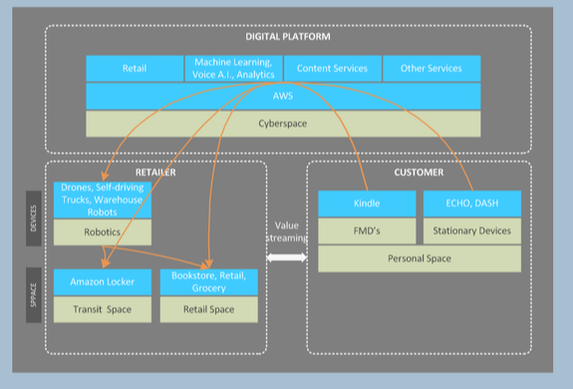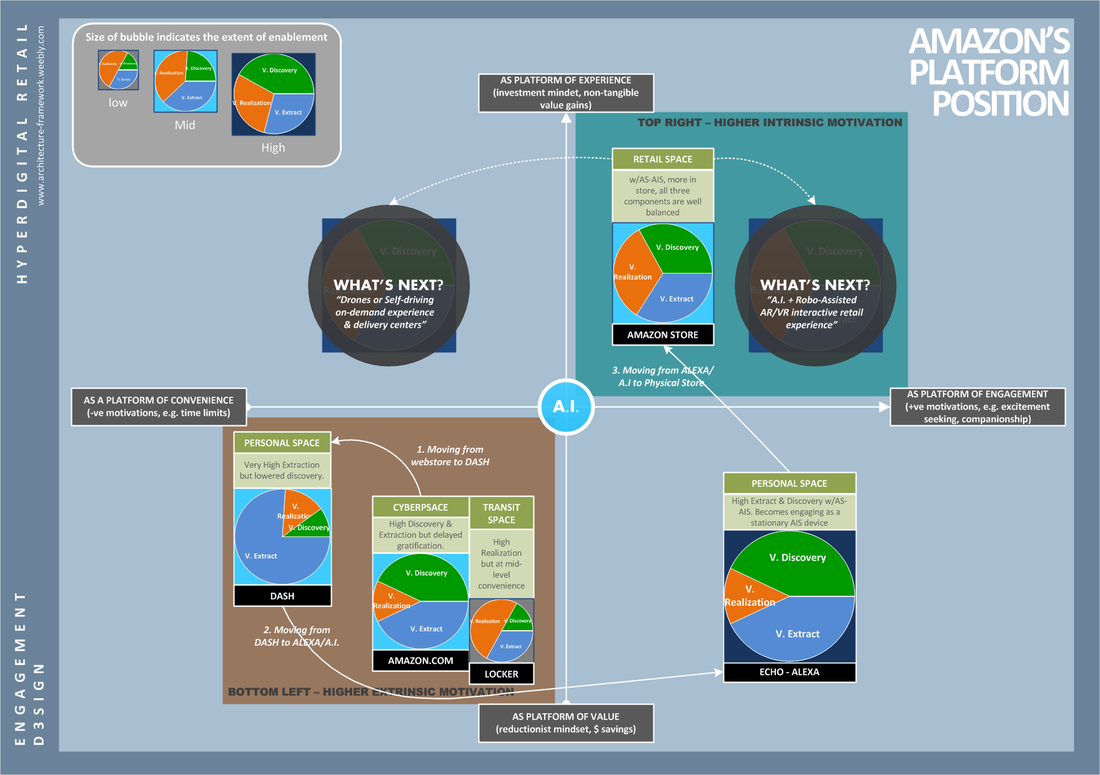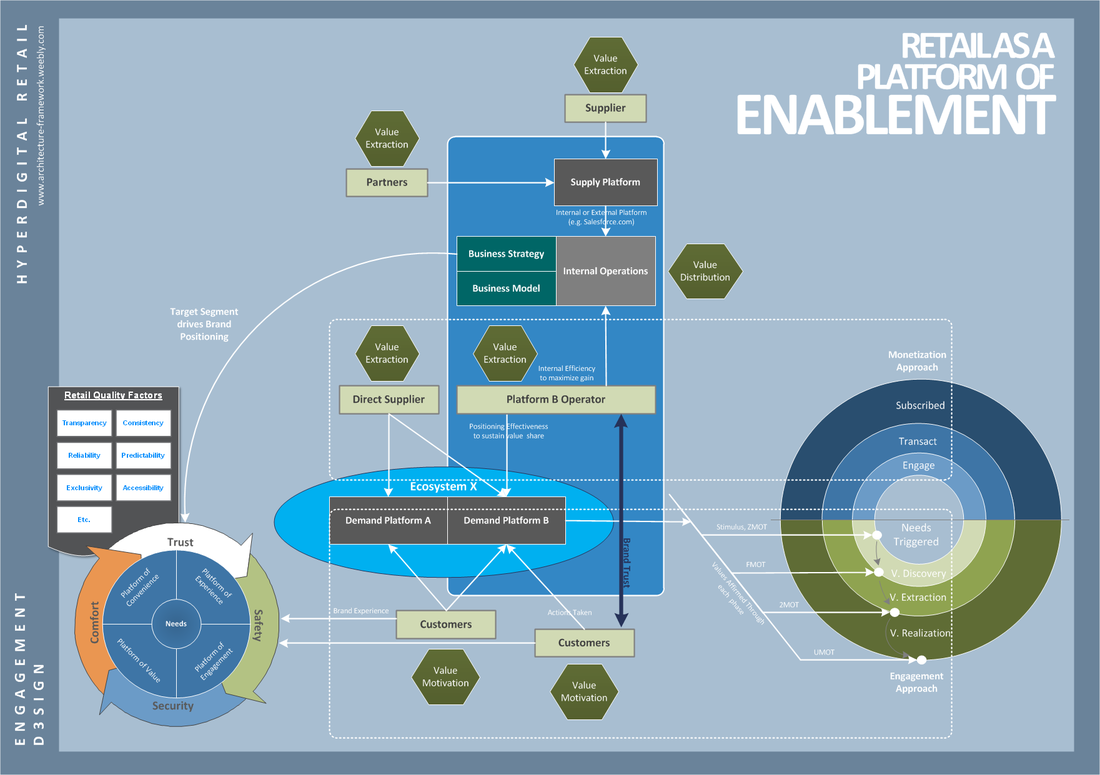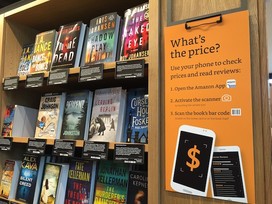|
CASE: From E-Commerce to physical Retail - Amazon The move of e-commerce giant into physical retail sparked much media frenzy. Such is the case when Amazon announced the setup of a bricks-and-mortar store. Much of the excitement stem from the expectation that Amazon will enter physical retail in a way that is disruptive - not just from a pricing standpoint but also at how they drive customer centricity. Amazon itself have always been looking at opportunity to have a physical storefront since the early days of Amazon.com but was hampered by the lack of synergistic partnership and changing internal priorities....until late 2016 of course, some 22 years after its establishment in 1994. NOTE: I've covered Amazon's IoT approach in separate blog here. It is easy to see how operating an e-commerce platform gave Amazon a head-start in the digital race - from the easy to use one-click buy to peer review and socialized reading list recommendations. Amazon who used its online book selling strength and expanded into other categories have proven how its capable of evolving around its core strength. I would make Amazon as a case study throughout this post and hope to unravel the architectural elements at play in building a hyper-connected retail concept. I would avoid calling it omnichannel retailing as this term has always been applied in a very narrow view (I'll explain in the later part of this blog). By the end of this blog post, I will present an architectural framework for use in positioning retail in the hyper-digital world. Amazon Retail is Hyper-connected As with most e-commerce sites Amazon started as a webstore and have moved on to engaging customers through smartphones (classified as FMD's in this blog). FMD's (follow-me devices) is increasingly becoming the mainstream engagement platform for many things including e-commerce. Whilst physical retailers build their mobile internet presence, Amazon is taking its first step in the physical retail world by taking 2 approaches: 1. Entering Customers Personal Space - Amazon went on introduced Dash and Echo devices to consumers. By placing physical devices in customer space, Amazon hopes to liberate customer from the need to remember and recall the need to purchase something. This approach offered minimal but meaningful productivity uplift to customers. More importantly usage of these devices shape behaviors, train new habit and eventually drive brand stickiness. These devices enabled value extraction in its most physically convenient way. (read more about value modelling here) 2. Bringing the Experience of Webstore to Physical Retail - Amazon chose to bring the goodness of its webstore experience (an approach I've covered as Value Streaming in a blog post here) into the physical realm. It further assured and strengthened the experience level. This is value discovery and realization for existing Amazon customers. (read more about value modelling here) These new physical devices took the retail world by surprise and introduced a whole new way of shopping - it brought the convenience of the webstore to the physical world! And within customer's personal space! (more about 'space' concept here) By adding a platform layer on top of the webstore and physical world, in the form Alexa and using Analytics to help stream/gain useful information, Amazon builds a 'Platform' overlay to drive engagement. This platform offers a two-way benefit to both customer and Amazon itself. Retail space shifting is now in full swing: Amazon's retail service now exists in customer personal space whilst its physical retail store brings a little of each customer's endorsed shared interest into the actual Amazon physical store. This interconnection very soon builds up to a point when that shared space between retailer and customer becomes significant and 'sticky' too. See diagram below for illustration: Nevertheless, this is nothing new to consumers as they are constantly looking for ways to improve productivity in the personal space. Consider the multiple types of systems you have at home: comfort systems, personal care systems, entertainment systems, etc. These systems gets more sophisticated as technology advances. The advancement itself fulfills needs and it in turn drives dependencies. These systems can be classified into tiered systems: 1. Tier-1: structural systems (SS) 2. Tier-2: passive systems (PS) 3. Tier-3: active intervention system (AIS) 4. Tier-4: autonomous system (AS) NOTE: The idea of tiered systems are first covered here in a separate blog entry. Retailers on the hand have generally been experimenting with AIS systems such as iBeacons, interactive screens, video analytics, dynamic pricing, mobile queuing and checkouts, etc for a while now. However, they usually approach this with the narrow objective of improving in-store sales & marketing operation. It is rarely seen as an opportunity to provide enablement and drive deeper customer engagement. To Amazon, their lack of physical retail presence probably pushed it to launch Echo, Dash and Alexa in the first place. But to a larger extent it was their appetite for continued 2-digit growth that prompted them to push into a new type digital engagement strategy - the hyperdigital engagement strategy. Hyper-digital vs Omni-channel Traditional retailers tend to focus on the 'box' - the physical space. Most strategies that follows need to maximize space use or revenue per square footage. Online retailers tend to focus on how UX can drive retail experience and engagement. They do so by designing a platform that is engagement and brings value by giving incentives or through the value of ecosystem interconnection. Omni-channel retailing typically focuses on pushing inventory via multiple types of channel. Digital in this case is merely an alternate sales/marketing funnel or a customer service channel. When retailer use it as a sales funnel, customer will treat it as no more than a broadcast channel. The effectiveness will be limited. When retailers are obsessed with owning and anchoring the channel to its traditional business model it limits the potential of what digital technologies can truly bring. What retailers need to do is to re-look into the business model with digital - not merely as a place to push inventory or as marketing tool with snazzy UX but as a place of enablement. Only then would digital make sense and are able to unlock the competitive value along with other digital 'allies' such as self-driving vehicles, robotics, consumer-friendly A.I., IoT, a long list of follow-me technologies (e.g. drones, phones, wearables, etc.) and cloud computing . Hyperdigital Retail encompasses a Sense of Fulfillment Retailers often position themselves in a combination of ways, either as convenience driven or experience driven. Both IKEA and Minotti places high emphasis on experience (see the related blog post here) in order to drive brand engagement. For retailers like Tesco or Walmart, the convenience and (economic) value factor ranks high. Even when these retailers go online or omni-channel, the basis of their position does not change. On the other hand, if these retailers want to consider hyper-digital strategy, the approach would be completely different. This would require them to develop a platform of shared and hyper-connected space. Consider Amazon's approach to create a holistic engagement experience, the diagram below illustrates Amazon's unique retail position and movement over the years. At the bottom left of quadrant is where customers mainly needs convenience (e.g. choice, time, distance, processing speed, delivery, etc.) and value savings (i.e. often with a very narrow focus on price alone). In this position, value extraction is the main emphasis. The top right quadrant is when customer seek less tangible form of return. Experience focused customer is those who typically emphasizes life-cycle journey instead of price alone such as skill attainment and accomplishment. Engagement is when customer seek positive motivations such as sense of social belonging, getting the creative boost by discovering new ideas or insights. In this position, value realization and value discovery is of relatively higher importance. Its important to know that the same individual customer can be in all four quadrants depending on the specific needs and offering. Amazon's Platform Position By taking full advantage of its nimble setup, Amazon spent years mastering the art of scaling big, sourcing cheap and selling fast. It did not take Amazon long to realize that there is only so much they could achieve in terms scale and reach if they were just playing at the bottom right quadrant. Without physical storefront, it's difficult to deliver similar shopping experience that physical retailers can achieve. Armed with years of customer insights, Amazon took a major step into physical space retail by introducing Dash and Echo-Alexa devices. The clever move positioned Amazon to quickly scale and engage customer in millions of physical storefronts not owned and maintained by Amazon - by placing Amazon devices in the homes of customers!! Central to the engagement strategy is the use of data analytics and insights to enable Value Streaming. After receiving encouraging results from the earlier device launches, Amazon quickly learned the immense potential of using A.I. and analytics in driving deeper engagement. Not content to just settle in the bottom right position it saw a need to create stronger brand presence and used the earlier advanced knowledge to develop a new physical retail approach. Amazon Bookstore and Amazon Go. Capability enablement is dotted along all the strategic steps taken by Amazon:
Retail-as-a-Platform of Enablement With the amount of technology available today, we are no longer limited to one specific ways of getting things done. Such is the case for both customer and retailers. Retailers must now be able to adapt and evolve. They must quickly pick and choose the appropriate engagement model. Planning and modelling requires a deep understanding of market and customer. Those who manage to make full use of data and analytics have an improved chance of survival. Those who understand demand & supply, engages deeply and evolves with time improves the chance of sustainability. Those who executes well on all that was mentioned and consciously build value-driven growth will survive, sustain and eventually thrive. The following model provides a starting point for that positioning and planning to take place. Pls. do drop me a mail ([email protected]) for sharing and more insights into the model: FURTHER READS: AMAZON RETAIL
Beyond the aesthetics appeal of the physical store layout, an information rich environment offers unparallelled value. Online commerce provides rich information that is otherwise not captured and harvested in the physical world. By combining its online and in-store appeal, Amazon hopes to build brand loyalty around book buyers who would otherwise only see Amazon as a transparent low-cost delivery channel. Their approach is to use rich data sets from its online store and turn it into a physical world buying experience. With a physical presence, Amazon can potentially capture browsing and reading habit in the physical world as well. This creates immense opportunity for cross-referencing customer behavior in both the online and offline world. Such trending data now enters a self-feedback loop. Traditional RetailIn contrast, traditional bricks-and-mortar retail rely a lot on physical queues (passive systems) and design aesthetics to drive store sales. Information elements are incorporated to provide perspectives but are often ignored by customer with skepticism or irrelevance. In the absence of transparency and community participation, brand building becomes a one-way broadcast exercise.
0 Comments
|
BackgroundUsing a combination of StAF and R3MAGICS, this blog post provides architecture analysis of the trend and major players in the retail market. R.3.M.A.G.I.C.S is short for Robotics, 3D Printing, Mobility, Analytics, Gamification, IoT, Cloud and Social platform. It encapsulates the key elements that will change the social-economic fabric in the coming years. StAF is short for Strategy-driven Architecture Framework. ArchivesCategories |






 RSS Feed
RSS Feed
